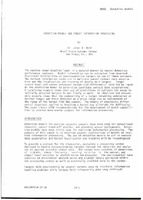| dc.contributor.author | Bond, James W. | |
| dc.date.accessioned | 2018-10-11T14:05:16Z | |
| dc.date.available | 2018-10-11T14:05:16Z | |
| dc.date.issued | 1982/06 | |
| dc.identifier | 626 | |
| dc.identifier.govdoc | CP-32/2 | |
| dc.identifier.uri | http://hdl.handle.net/20.500.12489/91 | |
| dc.description.abstract | The passive sonar equation leads in a natural manner to sensor detection performance contours. Useful information can be extracted from observed fractional holding time on non-cooperative targets by use of these contours. The derived information could aid in multiple sensor contact data association and the localization and tracking of poorly held targets. Target source level and sensor processor recognition differential need not be input to the prediction model to prioritize candidate contact data associations. A surprising example shows that use of predictions to estimate the range to initially detected targets is not likely to work. An idealized but reasonable example shows that the probability of a target remaining undetected at further ranges and first detected at a given range can be independent of the range of the target from the sensor. The theory of stochastic differential equations applied to tracking a target may alleviate the difficulty. The paper closes with recommendations for the development of model capabilities to provide more useful outputs for information processing. | |
| dc.format | 14 p. : ill. ; digital, PDF file | |
| dc.language | English | |
| dc.publisher | NATO. SACLANTCEN | |
| dc.source | In: Underwater Ambient Noise (SACLANTCEN Conference Proceedings CP-32), Vol. 2, Part 2, 1982, pp. 19-1 - 19-14. | |
| dc.subject | Passive sonar | |
| dc.subject | Data association | |
| dc.subject | Target detection | |
| dc.subject | Target tracking | |
| dc.subject | Multisensors | |
| dc.subject | Modelling and simulation | |
| dc.title | Detection models and target information processing | |
| dc.type | Papers and Articles | |
| dc.type | Conference Proceedings (CP) | |
